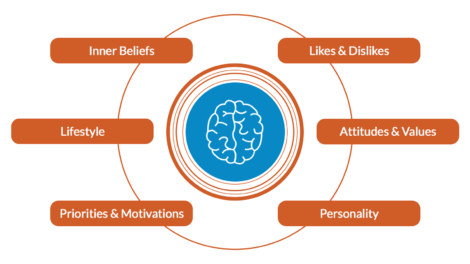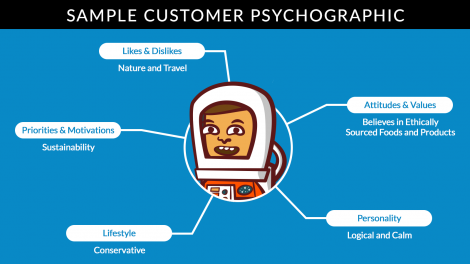Psychographic segmentation
- What is psychographic segmentation?
- What is psychographic segmentation in marketing?
- What are the psychographic characteristics of a customer?
- Conscious and subconscious belief systems
- Attitudes and values
- Likes and dislikes
- Priorities and motivations
- Personality
- Lifestyle
- How is psychographic segmentation used?
- Outsource
- Ask
- Dig
- Create
- Understand
- Now that you have the info, what do you do?
- What psychographic segments can I target on PickFu?
- Frequently Asked Questions:
What is psychographic segmentation?
While people don’t generally share their beliefs with casual friends and acquaintances, they do share them on Facebook. There’s a sense of safety in sharing articles and memes on the platform because you don’t have to see anyone react to you. Look at any news article’s Facebook comments and you’ll see a fascinating display of belief systems, opinions, values, and attitudes. These traits are the basis of psychographic segmentation.
Psychographic segmentation studies the less visible traits of a person. These include, but are not limited to: beliefs and values; psychographic characteristics such as priorities, likes, dislikes, lifestyles, interests, and motivations; and conscious and subconscious beliefs. At a high level, a belief can be defined as a person’s likes and dislikes which behavior helps dictate.
While you can see a lot of this on social media platforms like Facebook, many of the traits are so internal that you have to work to figure them out.
That’s why psychographic segmentation, wherein your audience is segmented according to similarities in these inner characteristics, can be so tricky.
What is psychographic segmentation in marketing?
Psychographic market segmentation might be tricky, but it’s also deeply valuable. After all, what’s
Think about giving gifts to your friends and family: it’s easiest to gift when you know a person inside and out. It’s hardest when you know them tangentially and
In marketing, psychographic segmentation enables brands to reach their customers’ deepest thoughts and feelings and use that information to give them the best version of your brand and its products.
What are the psychographic characteristics of a customer?
What are psychographic factors? How do you define psychographics? To start understanding psychographic segmentation, it helps to study how each psychographic characteristic influences your audience.
Conscious and subconscious belief systems
What someone believes, whether they’re conscious of that belief or not, influences what they buy. Take HarperCollins, a leading book publisher. This enormous publisher owns edgy YA imprint HarlequinTEEN on one end and Thomas Nelson Books (and Bibles) on the other.
While these two imprints could appeal to the same crowd, they probably won’t. HarperCollins definitely knows who in their audience holds a religious viewpoint on life and who has, instead, a taste for edgy romance, horror, and more.
Attitudes and values
It pays to know what types of values people hold dear, and what attitudes they have toward different aspects of life. If, for example, you’re a school supplies company that aims to sell to homeschoolers or the ever-growing crowd of unschooling parents, you need to understand their attitudes. An advertisement that shows a back-to-school scene complete with lockers, backpacks, and whiteboards won’t appeal to homeschooling parents. Send an ad like that to parents who have negative attitudes toward formal school and you’ll waste your money.
But don’t count those audience members out! Those parents might be interested in your new at-home science kits and art boxes. Unschooling parents might be trickier to buy for because they tend to be less materialistic, but there might be a service of yours or an out-of-the-box type of product they’d be interested in buying — if you wrap it up in supremely tailored marketing (picture a child running through the forest, learning math by counting trees, or learning language by composing poetry about the outdoors, and so on).
Likes and dislikes
With a quick and easy survey, you can find out what your audience members’ likes and dislikes are. If your company has a Facebook page or Twitter account, you can browse your followers’ accounts and see what likes and dislikes they share with the public.
Twitter will often tell you what types of things people don’t like, while Facebook has a whole section of each person’s profile dedicated to displaying their various “likes”: organizations, books, movies, restaurants, and so on.
While gathering this information may be time-consuming, it’s worth knowing which of your customers like (and dislike) similar things. If you’re a health and fitness company, you could send out a survey that includes a question like this:
On a Sunday afternoon, I’m most likely to hit up the…
- Spa, because relaxation is important to my health.
- Gym. I never miss a workout!
- Hiking trail. There’s no better gym than the Great Outdoors.
Group respondents according to what they chose — 1, 2, or 3. Then, tailor your product campaigns accordingly. Knowing what types of activities your target audience enjoys can make you confident in creating advertisements that will earn you conversions.
Priorities and motivations
Why does your customer go to work every day — to support her family or earn money for amazing trips to other countries? Even if you’re not a travel or work-related company, it’s important to know what motivates your customer.
If they’re family-oriented, an advertisement promising that your product will give them more family time will be of more value to them (and you) than an advertisement that’s open-ended. You don’t want to promote your product or service as an additional thing they have to leave home to get.
Say you are a travel company. Because you’ve implemented psychographic segmentation and know your target audience, you target your family-oriented audience with an advertisement showing a family frolicking in foamy waves. You send a different advertisement to the women in your audience who love to travel with friends. In that ad, you feature the same beach. But this time it’s at sunset, and the women are clinking wine glasses and laughing together.
Knowing where your audience’s interests lie is crucial to your success.
Personality
Is your customer logical, reasonable, and preternaturally calm? Or do they weep at those sentimental beer commercials? Maybe they love a good joke instead.
Different personalities will respond to campaigns in different ways. You can appeal to your emotions-based audience members with campaigns that tug on their heartstrings. For your humor-loving customers, make every ad Superbowl-commercial funny (or funnier!) Those that love logic and reason will need as many facts and statistics as possible in ads targeted at them; they want information and proof, not jokes.
Know your target audience’s personalities and segment them according to the similarities. Then you’ll be ready for all sorts of people to get interested in your brand.
Lifestyle
You’ve heard it before: the phrase “live within your means.” This means to not spend more money than you have, but also to enjoy what you do buy within your range of guilt-free spending.
A means is, essentially, a lifestyle: the way your audience members spend their time and money on a variety of products, services, and activities.
For psychographic lifestyle segmentation, you need to know your audience’s varying lifestyles. For example, there will be those in your audience who identify with a working-class community and mindset. They’re less likely to spend on daily luxuries and more likely to save up for something big and meaningful. Then there will be those on the social ladder who consider weekly pedicures and facials essential to their wellbeing.
You can make your brand inviting to everyone, as long as you’ve segmented your audience’s lifestyles and adjust your campaigns to suit each different group.
How is psychographic segmentation used?
Before you can use psychographic segmentation, you have to do a lot of research or hire someone to do it for you. Either way, put a lot of consideration into it, because the information you’re gathering is intangible, delicate, and subject to change at any time, as people often do.
There are several different ways to go about finding the information you need.
Outsource
Hire a market research firm like Nielsen or Kantar to research your buyers’ psychographic traits for you. This will cost you a pretty
Ask
Use a polling site like PickFu to create polls and surveys to send to your audience members/potential buyers. While this involves more work for you, the cost is much less than hiring a research firm.
Dig
Gather data yourself from what’s available on Facebook, Twitter, and Instagram.
Create
Create a psychographic profile or buyer persona tailored to psychographics. Find out who your potential buyers are and then gather all that psychographic data about them. Add as many demographic and psychographic traits to these partly fictional personas as you can. This will give you an idea of the different ways in which your potential buyers might think, and can help you bounce advertisement ideas around that can suit your buyers’ different identities.
Understand
Know your customers’ buying patterns — how frequently they purchase, how much, for how long, and when. This deals more with behavioral segmentation but
Now that you have the info, what do you do?
It’s pretty simple: group like-minded audience members into segments and create campaigns tailored to each segment.
Remember, whatever work you do or money you invest will pay itself back in spades when you’re able to market your brand according to your audience’s psychographic characteristics.
You will be targeting your customers so closely, your brand will be irresistible to them. You know what makes them tick, what their pain points are, what they like and hate and
Keep your customers happy when you do get them to convert to your brand and you’ll likely have them buying your products and services for a long, long time.
What psychographic segments can I target on PickFu?
On PickFu, you can target the following psychographic segments:
- Political affiliation (Democrat, Republican, political independent/other)
- Religious affiliation (Christian, non-religious, other)
- Sexual orientation (heterosexual, LGBT+)
Frequently asked questions
Psychographic segmentation is the study of your target audience’s inner beliefs, values, attitudes, and opinions, and the formation of groups according to these similarities.
Lifestyle-based segmentation, social class-based segmentation, attitude- and values-based segmentation, personality-based segmentation, interests-based segmentation.
A grouping of psychographic characteristics that define a psychographic audience segment or buyer persona.
How frequently your customers purchase, how much they buy, for how long, and when.
Demographic deals with exterior information: your audience’s age, gender, income, education, occupation, and so on. Psychographic is all information found inside your buyers’ hearts and minds: their beliefs, values, attitudes, opinions, likes, dislikes, and more.


